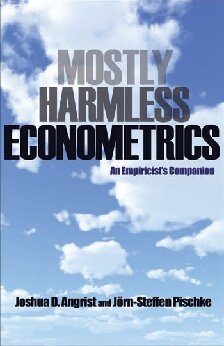

Most ebook files are in PDF format, so you can easily read them using various software such as Foxit Reader or directly on the Google Chrome browser.
Some ebook files are released by publishers in other formats such as .awz, .mobi, .epub, .fb2, etc. You may need to install specific software to read these formats on mobile/PC, such as Calibre.
Please read the tutorial at this link: https://ebookbell.com/faq
We offer FREE conversion to the popular formats you request; however, this may take some time. Therefore, right after payment, please email us, and we will try to provide the service as quickly as possible.
For some exceptional file formats or broken links (if any), please refrain from opening any disputes. Instead, email us first, and we will try to assist within a maximum of 6 hours.
EbookBell Team

0.0
0 reviews
ISBN 10: 0691120358
ISBN 13: 9780691120355
Author: Joshua D Angrist, Jorn Steffen Pischke
From Joshua Angrist, winner of the Nobel Prize in Economics, and Jörn-Steffen Pischke, an irreverent guide to the essentials of econometrics The core methods in today's econometric toolkit are linear regression for statistical control, instrumental variables methods for the analysis of natural experiments, and differences-in-differences methods that exploit policy changes. In the modern experimentalist paradigm, these techniques address clear causal questions such as: Do smaller classes increase learning? Should wife batterers be arrested? How much does education raise wages? Mostly Harmless Econometrics shows how the basic tools of applied econometrics allow the data to speak. In addition to econometric essentials, Mostly Harmless Econometrics covers important new extensions—regression-discontinuity designs and quantile regression—as well as how to get standard errors right. Joshua Angrist and Jörn-Steffen Pischke explain why fancier econometric techniques are typically unnecessary and even dangerous. The applied econometric methods emphasized in this book are easy to use and relevant for many areas of contemporary social science. An irreverent review of econometric essentials A focus on tools that applied researchers use most Chapters on regression-discontinuity designs, quantile regression, and standard errors Many empirical examples A clear and concise resource with wide applications
I: Preliminaries
1 Questions about Questions
2 The Experimental Ideal
2.1 The Selection Problem
2.2 Random Assignment Solves the Selection Problem
2.3 Regression Analysis of Experiments
II: The Core
3 Making Regression Make Sense
3.1 Regression Fundamentals
3.1.1 Economic Relationships and the Conditional Expectation Function
3.1.2 Linear Regression and the CEF
3.1.3 Asymptotic OLS Inference
3.1.4 Saturated Models, Main Effects, and Other Regression Talk
3.2 Regression and Causality
3.2.1 The Conditional Independence Assumption
3.2.2 The Omitted Variables Bias Formula
3.2.3 Bad Control
3.3 Heterogeneity and Nonlinearity
3.3.1 Regression Meets Matching
3.3.2 Control for Covariates Using the Propensity Score
3.3.3 Propensity Score Methods versus Regression
3.4 Regression Details
3.4.1 Weighting Regression
3.4.2 Limited Dependent Variables and Marginal Effects
3.4.3 Why Is Regression Called Regression, and What Does Regression to the Mean Mean?
3.5 Appendix: Derivation of the Average Derivative Weighting Function
4 Instrumental Variables in Action: Sometimes You Get What You Need
4.1 IV and Causality
4.1.1 Two-Stage Least Squares
4.1.2 The Wald Estimator
4.1.3 Grouped Data and 2SLS
4.2 Asymptotic 2SLS Inference
4.2.1 The Asymptotic Distribution of the 2SLS Coefficient Vector
4.2.2 Overidentification and the 2SLS Minimand
4.3 Two-Sample IV and Split-Sample IV
4.4 IV with Heterogeneous Potential Outcomes
4.4.1 Local Average Treatment Effects
4.4.2 The Compliant Subpopulation
4.4.3 IV in Randomized Trials
4.4.4 Counting and Characterizing Compliers
4.5 Generalizing LATE
4.5.1 LATE with Multiple Instruments
4.5.2 Covariates in the Heterogeneous Effects Model
4.5.3 Average Causal Response with Variable Treatment Intensity
4.6 IV Details
4.6.1 2SLS Mistakes
4.6.2 Peer Effects
4.6.3 Limited Dependent Variables Reprise
4.6.4 The Bias of 2SLS
4.7 Appendix
5 Parallel Worlds: Fixed Effects, Differences-in-Differences, and Panel Data
5.1 Individual Fixed Effects
5.2 Differences-in-Differences
5.2.1 Regression DD
5.3 Fixed Effects versus Lagged Dependent Variables
5.4 Appendix: More on Fixed Effects and Lagged Dependent Variables
III: Extensions
6 Getting a Little Jumpy: Regression Discontinuity Designs
6.1 Sharp RD
6.2 Fuzzy RD Is IV
7 Quantile Regression
7.1 The Quantile Regression Model
7.1.1 Censored Quantile Regression
7.1.2 The Quantile Regression Approximation Property
7.1.3 Tricky Points
7.2 IV Estimation of Quantile Treatment Effects
7.2.1 The QTE Estimator
8 Nonstandard Standard Error Issues
8.1 The Bias of Robust Standard Error Estimates
8.2 Clustering and Serial Correlation in Panels
8.2.1 Clustering and the Moulton Factor
8.2.2 Serial Correlation in Panels and Difference-in-Difference Models
8.2.3 Fewer than 42 Clusters
8.3 Appendix: Derivation of the Simple Moulton Factor
mostly harmless econometrics instrumental variable
mostly harmless econometrics vs mastering metrics
mostly harmless econometrics lecture notes
angrist jd & pischke js 2009 mostly harmless econometrics
joshua angrist mostly harmless econometrics
mostly harmless econometrics jstor
Tags: Joshua D Angrist, Jorn Steffen Pischke, Econometrics, Harmless